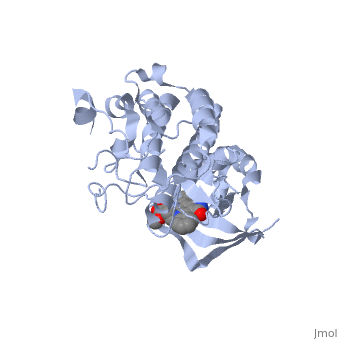User:Juliette Personius/sandbox 1
From Proteopedia
Contents |
Hepatocyte Growth Factor Receptor c-Met
Introduction
The Hepatocyte growth factor Receptor plays a large role in embryonic development, as its activation leads to events such as cell growth, motility and invasion. This receptor is a Tyrosine Kinase, and is one of the most well studied RTKs, as mutations in the c-met protooncogene can lead to tumorigenesis. The ligand for this receptor is Hepatocyte growth factor/scatter factor (HGF/SF), and upon binding of this ligand, the receptor becomes auto phosphorylated, causing downstream signaling events such as cell growth. [1]
Structure
Some of the most important aspects of this RTK are the tyrosines at position 1234 and 1235. These are located within the activation loop (A loop), and upon ligand binding, will become phosphorylated. Studies with mice have shown that these tyrosines are necessary for normal c-met signaling. When these two tyrosines were substituted with with phenylalenine, the mice had an embryonically lethal phenotype and defects were found in placenta, liver, muscles and nerves. [2] In a wild type c-met, these sites will become phosphorylated and act as docking sites for many different transducers and activators. [3]
</StructureSection>
| |||||||||
| 1r1w, resolution 1.80Å () | |||||||||
|---|---|---|---|---|---|---|---|---|---|
| Gene: | MET (Homo sapiens) | ||||||||
| Activity: | Transferase, with EC number and 2.7.10.2 2.7.10.1 and 2.7.10.2 | ||||||||
| Related: | 1r0p | ||||||||
| |||||||||
| |||||||||
| |||||||||
| Resources: | FirstGlance, OCA, RCSB, PDBsum | ||||||||
| Coordinates: | save as pdb, mmCIF, xml | ||||||||
Mutation
This particular strcuture of the hepatocyte growth factor tyrosine kinase domain is one harboring a human cancer mutation. The two tyr1234 and tyr1235 are replaced by a phenylalanine and aspartate, respectively. This mutation normally causes the receptor to be consitutively active. Although there is no longer phosphorylation at these sites, it is believed that the aspartate negative charge resembles the negative phosphate that would normally cause activation, and therefore keeps the protein in its active form. [4]


